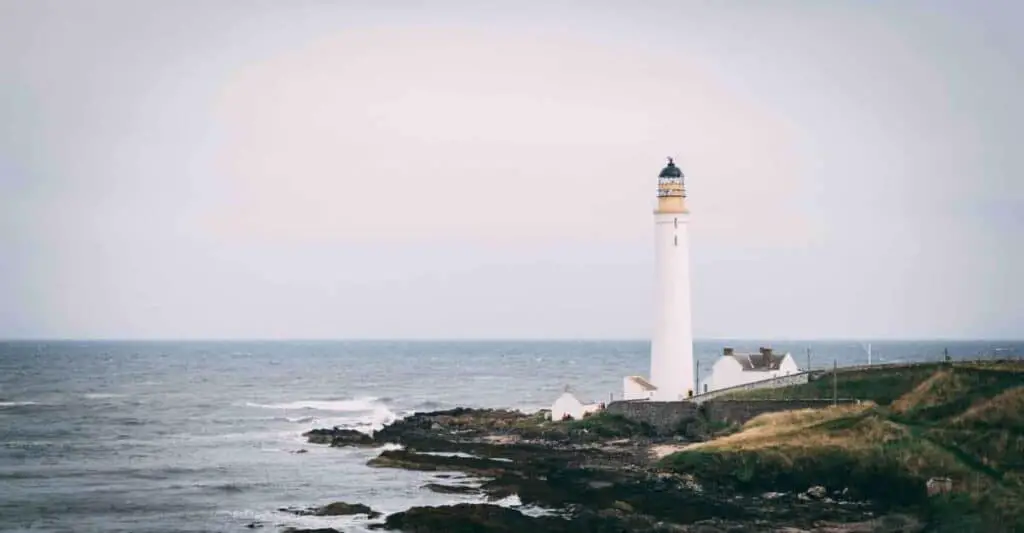Menu
Menu

The Cape Hatteras lighthouse is in Buxton, North Carolina. It is on Hatteras Island and is considered a part of the Cape Hatteras National Seashore. The Cape Hatteras lighthouse consisted of a Principal Keeper and two Assistant Keepers. But today its care and upkeep are National Park Service managed. While operation and maintenance of the automated light is U.S. Coast Guard managed.
The Cape Hatteras Lighthouse protects a very hazardous segment of the Atlantic Ocean. Two powerful currents, the Gulf Stream and the Virginia Drift meet, at this segment. It is also the location of a twelve-mile sandbar known as the Diamond Shoals. These factors have been responsible for reportedly thousands of shipwrecks. And over the years has earned itself the name of the Graveyard of the Atlantic.
It is rumored that then-Secretary of the Treasury, Alexander Hamilton, made the initial request to Congress for a lighthouse. It was to be constructed on Cape Hatteras after his ship narrowly escaped defeat on its way to the New World in 1794. And although the request was eventually authorized due to the recognized dangers of the area. Tower construction did not begin until 1799. Only 90 feet tall and made of sandstone, the first lighthouse to serve the area was lit in 1803.
Though an improvement over no signal at all. At only 90 feet tall the lighthouse was not real effective at warning passing ships of the surrounding hazards of Diamond Shoals. For one, the signal was not strong enough, and two, the tower demanded constant maintenance.
Studies for better effectiveness were then conducted by the Lighthouse Board. And in 1853, an extra 60 feet was added to the height of the tower. And the lens was upgraded to a first-order Fresnel lens, which resulted in a much more powerful beam. This newly built tower was painted red on top so it was more recognizable during the day.
Unfortunately, these improvements did not last very long. The Cape Hatteras Lighthouse was reportedly destroyed by the Confederate Army during the Civil War in 1862. In an attempt to keep the Union ships from benefiting from its service.
When the Civil War concluded and peace was restored across the country. The Lighthouse Board considered making repairs and rebuilding. But after extensive analysis, it was more cost-effective to begin construction on a new lighthouse in a better location. The Lighthouse Board then submitted its plans to Congress. And after the approval of funds, the construction of this new lighthouse started in 1868.
Construction of this new Cape Hatteras Lighthouse cost approximately $167,000 dollars. And when it was first brought into service in 1871, it became the tallest brick lighthouse in the world.
It was now 200 feet tall with improved focal strength of light, now standing at a height of 208 feet above the water. The old tower was demolished in 1871. Scattered remains of its former glory were still standing until 1980. Until erosion and father time finally won out.
The Cape Hatteras Lighthouse was built as a conical brick structure. That had an octagon-shaped brick and granite base and was topped with a glass lantern. It was painted the now famous black and white stripe daymark pattern in 1873. The Lighthouse Board assigned each lighthouse a distinctive paint pattern and light sequence. This allowed mariners to recognize it from all others as they sailed along the coast.
The Cape Hatteras Lighthouse is the tallest brick lighthouse in the United States. It measures 198.49 feet from the bottom of the foundation to the top of the pinnacle of the tower. This height helped to extend the light’s range from the low-lying beach site. The tower’s construction includes interior brick walls much like the spokes of a wheel. There are 269 steps up to the lens room of the lighthouse.
The Bureau of Lighthouses shut down the Cape Hatteras Lighthouse in 1935. As a result of threatening beach erosion. But the beacon remained in operation and was moved to a steel tower until 1950. In 1937, care-taking management for the Cape Hatteras Lighthouse. Was given to the National Park Service. The lighthouse and the keepers' quarters were combined. And they became part of the Cape Hatteras National Seashore.
In 1950, the Coast Guard re-established the lighthouse. After the beach had been re-engineered the last several years at the lighthouse’s front or beachside. In 1972, the beacon’s intensity was increased to better serve those passing ships. Since its re-establishment, many attempts were made to restore the beach. But the erosion was relentless. The beach would eventually give way to mother nature’s repeated attempts. In fact, it was a winter storm in 1980 that seriously harmed the surrounding dunes. And even claimed what remained of the older 1803 lighthouse.
While the National Park Service had done its best to uphold the preservation of the structure and maintain the surrounding coastal area. It was decided that the Cape Hatteras Lighthouse would be moved to its current location in 1999. The Cape Hatteras Lighthouse is also known as The Cape Hatteras Light Station. It was moved 2,900 feet in 23 days and now lies 1,500 feet from the seashore, its original distance from the sea. The other facilities are now known as the Cape Hatteras National Seashore. Which included the Keepers’ Quarters, the dwelling cisterns, and the oil house. Were all relocated as well although ahead of the Light Station move.
The Cape Hatteras Lighthouse, guardian of those who travel the demanding Diamond Shoals. And long-standing witness to the many tragedies and historic saves in the Graveyard of the Atlantic. Was put back into service in 1999 and has remained to the current day. Now protected by a 1,500 feet move away from the ocean. It will continue to be of service to those adventuresome travelers for another 100 years.